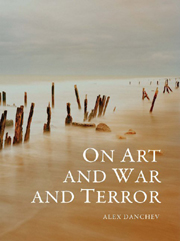Photographic portraits, the late Alex Danchev suggests in On Art and War and Terror (published in 2009), “are not merely illustrations of what was already known. They are new knowledge” (p. 36) and a fiction may be “a type of truth” (p. 148), requiring new thinking and writing techniques to grasp what is normally considered intangible, ephemeral, even – from the point of view of most scholarship – irrelevant. This book shows that it is not irrelevant: “art articulates a vision of the world that is insightful and consequential; and the vision and the insight can be analysed” (p. 4).
The book shows much more than that, of course. It follows the author’s radical, individual perspective, largely unbothered by the academic theory on arts and politics that started to emerge at the time. Some readers may regard this as a liability; others will enjoy it.
The essays on, for example, film after 9/11, war photography, paintings, war diaries, war poetry and biographical writing are “an experiment in thinking otherwise, in being other-wise” (p. 4), an attempt to mingle “the practical and the poetic” (Seamus Heaney): the author as “smuggler, interpreter and facilitator across the frontier” (p. 4) that is there to be crossed – and as detective. In chapter 3, Danchev traces the provenance of Georges Braque’s painting The Guitar Player through the vicissitudes of the 20th century. The chapter ends, in a surprising manner, with reflections on another guitar player, Tony Blair, and his failure to authenticate his provenance: “Posing is seeming gone wrong” (p. 71).
When reading this thoughtful and elegant book, terms such as lucid and illuminating come to mind, all of which are analytically weak but indicative nevertheless of what makes this book a rich reading experience. The book casually yet quite irresistibly touches upon many critical concepts that figure prominently in current scholarship. The author is not impressed by disciplinary borders: borders are there to be ignored, frontiers are meeting-places. Art thinks (p. 40). Art makes us think. Art makes us think otherwise. Art helps us make a judgement, a moral judgement.
The photographer Don McCullin took pictures of – and is haunted by – war and its many ghosts. Simon Norfolk witnessed, and makes us witness, the aftermath of war thus contributing to our knowledge on war. The painter Gerhard Richter witnessed the German autumn and transformed it into works of art. Evelyn Waugh referenced the slaughter and atrocities of World War II mainly by implication while focusing on “fiasco and folly,” “chance and probability” (p. 129). He sympathized with the soldier, continued to believe in “compassion” and recognised the mismatch between personal aphorisms and the realpolitik of the Great Powers.
In World War I, Basil Liddell Hart witnessed his own learning process. The “disquieting things” (p. 84) he learned about himself included a dislike of being alone, helpless and bereft, “of being afraid – and of yielding to fear. […] he was reluctant to admit that he was also afraid of being thought to be afraid” (p. 94) – and for this reason, perhaps, never entirely abandoned the idea, absurd given his own experience, that war can be noble.
We are living in the era of the witness and in the era of the spectator: Richter’s paintings of Gudrun Ensslin (Confrontation 1, 2 and 3) “have a feeling almost of complicity with the viewer” (p. 18). Ensslin seems to be establishing eye contact with the viewers, involving them in the scene depicted. The photographs after which Richter painted his famous paintings, however, were taken clandestinely. Faces in photographs, discussed in terms suggested by Emmanuel Levinas, tell us as much about themselves as they tell us about us, the spectators (p. 38). Ultimately, the question of spectatorship is an ethical one.
The one thing the “Global War on Terror” is not is ethical. For Danchev, it is “Kafkaesque” (p. 172), menacing, humiliating, shameless. Three photographs taken at Abu Ghraib prison in 2003 are reproduced in the book; they confirm the above. The subject position of the reader/viewer is not discussed, though, and this is a curious omission in a book that has so much to say about the witness and the spectator. How do these images affect us? How can we possibly respond?
In Standard Operating Procedure, Errol Morris and Philip Gourevitch explain that occasionally photography was the occasion for what was going on, not a response to it: a crime committed for the purpose of the production of images. Looking at such images strongly involves the viewer who joins hands with the perpetrators.
In the European imagination, “waiting for the barbarians has become a habit” (p. 231). We do not have to wait any longer. The barbarians are already here. They are us.
“Art returns, as Paul Celan said” (p. 27); “I have never thought for one moment that art is an illusion,” as Georges Braque wrote (p. 102); “it is given to artists, not politicians, to make a new world order,” as Alex Danchev writes (p. 59).
Alex Danchev
On Art and War and Terror
Edinburgh: Edinburgh University Press
2009
242 pp.

